Related Research Articles
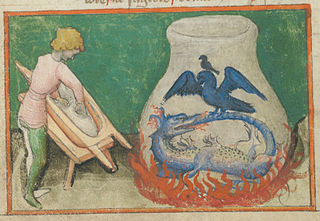
Alchemy is an ancient branch of natural philosophy, a philosophical and protoscientific tradition that was historically practiced in China, India, the Muslim world, and Europe. In its Western form, alchemy is first attested in a number of pseudepigraphical texts written in Greco-Roman Egypt during the first few centuries AD.
Chemistry is the scientific study of the properties and behavior of matter. It is a physical science under natural sciences that covers the elements that make up matter to the compounds made of atoms, molecules and ions: their composition, structure, properties, behavior and the changes they undergo during a reaction with other substances. Chemistry also addresses the nature of chemical bonds in chemical compounds.

Lactose is a disaccharide sugar synthesized by galactose and glucose subunits and has the molecular formula C12H22O11. Lactose makes up around 2–8% of milk (by mass). The name comes from lac (gen. lactis), the Latin word for milk, plus the suffix -ose used to name sugars. The compound is a white, water-soluble, non-hygroscopic solid with a mildly sweet taste. It is used in the food industry.
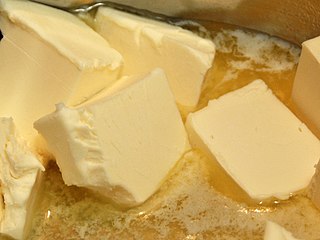
Butter is a dairy product made from the fat and protein components of churned cream. It is a semi-solid emulsion at room temperature, consisting of approximately 80% butterfat. It is used at room temperature as a spread, melted as a condiment, and used as a fat in baking, sauce-making, pan frying, and other cooking procedures.
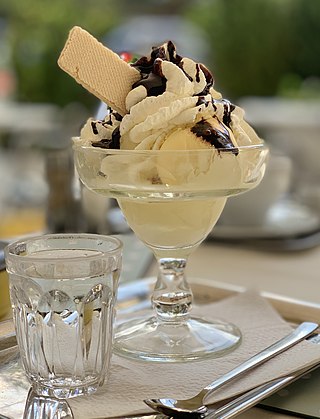
Ice cream is a frozen dessert, typically made from milk or cream and flavoured with a sweetener, either sugar or an alternative, and a spice, such as cocoa or vanilla, or with fruit such as strawberries or peaches. It can also be made by whisking a flavored cream base and liquid nitrogen together. Food coloring is sometimes added, in addition to stabilizers. The mixture is cooled below the freezing point of water and stirred to incorporate air spaces and to prevent detectable ice crystals from forming. The result is a smooth, semi-solid foam that is solid at very low temperatures. It becomes more malleable as its temperature increases.

Manna is, according to the Bible, an edible substance which God provided for the Israelites during their travels in the desert during the 40-year period following the Exodus and prior to the conquest of Canaan. It is also mentioned in the Quran three times.

Robert Fludd, also known as Robertus de Fluctibus, was a prominent English Paracelsian physician with both scientific and occult interests. He is remembered as an astrologer, mathematician, cosmologist, Qabalist and Rosicrucian.

Paracelsus, born Theophrastus von Hohenheim, was a Swiss physician, alchemist, lay theologian, and philosopher of the German Renaissance.
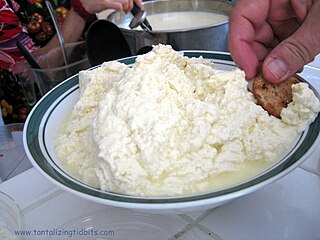
Ricotta is an Italian whey cheese made from sheep, cow, goat, or Italian water buffalo milk whey left over from the production of other cheeses. Like other whey cheeses, it is made by coagulating the proteins that remain after the casein has been used to make cheese, notably albumin and globulin.
Rasāyana (रसायन) is a Pali and Sanskrit word literally meaning path (ayana) of essence (rasa). It is an early ayurvedic medical term referring to techniques for lengthening lifespans and invigorating the body. It is one of the eight areas of medicine in Sanskrit literature. In Vedic alchemical context, "rasa" also translates to "metal or a mineral"

Blue cheese is semi-soft cheese with a sharp, salty flavor. It is made with cultures of the edible mold Penicillium, giving it spots or veins throughout the cheese in shades of blue or green. It carries a distinct smell, either from the mold or from various specially cultivated bacteria such as Brevibacterium linens, which also causes foot odor and other human body odors.
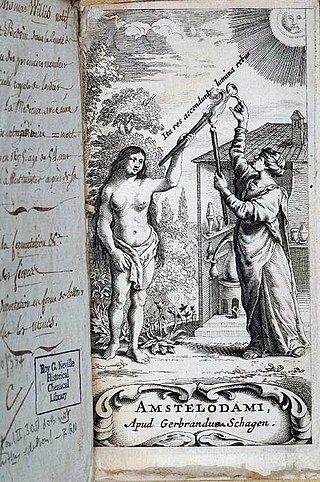
Iatrochemistry is a branch of both chemistry and medicine. Having its roots in alchemy, iatrochemistry seeks to provide chemical solutions to diseases and medical ailments.

During the Renaissance, great advances occurred in geography, astronomy, chemistry, physics, mathematics, manufacturing, anatomy and engineering. The collection of ancient scientific texts began in earnest at the start of the 15th century and continued up to the Fall of Constantinople in 1453, and the invention of printing allowed a faster propagation of new ideas. Nevertheless, some have seen the Renaissance, at least in its initial period, as one of scientific backwardness. Historians like George Sarton and Lynn Thorndike criticized how the Renaissance affected science, arguing that progress was slowed for some amount of time. Humanists favored human-centered subjects like politics and history over study of natural philosophy or applied mathematics. More recently, however, scholars have acknowledged the positive influence of the Renaissance on mathematics and science, pointing to factors like the rediscovery of lost or obscure texts and the increased emphasis on the study of language and the correct reading of texts.
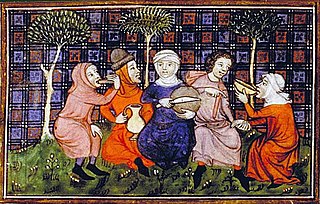
Medieval cuisine includes foods, eating habits, and cooking methods of various European cultures during the Middle Ages, which lasted from the fifth to the fifteenth century. During this period, diets and cooking changed less than they did in the early modern period that followed, when those changes helped lay the foundations for modern European cuisine.
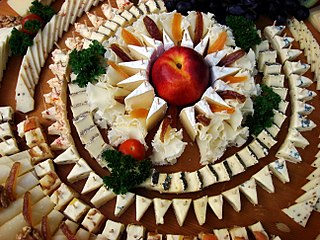
Cheese is a dairy product produced in wide ranges of flavors, textures, and forms by coagulation of the milk protein casein. It comprises proteins and fat from milk. During production, milk is usually acidified and either the enzymes of rennet or bacterial enzymes with similar activity are added to cause the casein to coagulate. The solid curds are then separated from the liquid whey and pressed into finished cheese. Some cheeses have aromatic molds on the rind, the outer layer, or throughout.
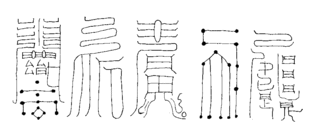
The Baopuzi is a literary work written by Ge Hong (葛洪), 283–343, a scholar during the turbulent Jin dynasty. Baopuzi is divided into two main sections, the esoteric Neipian (內篇) "Inner Chapters" and the section intended for the public to understand, Waipian (外篇) "Outer Chapters". The Taoist Inner Chapters discuss topics such as techniques to achieve "hsien" (仙) "immortality; transcendence", Chinese alchemy, elixirs, and demonology. The Confucian Outer Chapters discuss Chinese literature, Legalism, politics, and society.
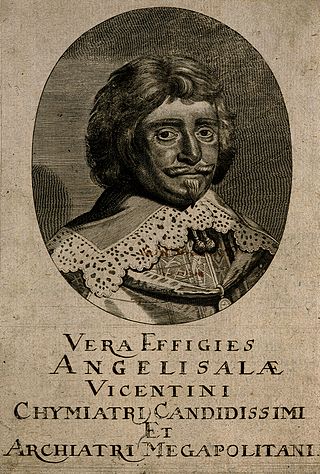
Angelo Sala was an Italian doctor and early iatrochemist. He promoted chemical remedies and, drawing on the relative merits of the conflicting chemical and Galenical systems of medicine, dismissed alchemical transmutation and 'universal medicine'; objected to tartar which had deliquesced being called an 'oil'; observed that metals reacted differently with acids; that sulphur extracted something from the air in order to burn; that silver nitrate darkened on exposure to light; surmised the existence of elementary (atomic) particles; and described newly discovered compounds and methods of preparation. Sala made the first studies on the formation of alcohol from fermenting musts and so is regarded as the founder of sugar chemistry.

Waidan, translated as 'external alchemy' or 'external elixir', is the early branch of Chinese alchemy that focuses upon compounding elixirs of immortality by heating minerals, metals, and other natural substances in a luted crucible. The later branch of esoteric neidan 'inner alchemy', which borrowed doctrines and vocabulary from exoteric waidan, is based on allegorically producing elixirs within the practitioner's body, through Daoist meditation, diet, and physiological practices. The practice of waidan external alchemy originated in the early Han dynasty, grew in popularity until the Tang (618–907), when neidan began and several emperors died from alchemical elixir poisoning, and gradually declined until the Ming dynasty (1368–1644).

In Chinese alchemy, elixir poisoning refers to the toxic effects from elixirs of immortality that contained metals and minerals such as mercury and arsenic. The official Twenty-Four Histories record numerous Chinese emperors, nobles, and officials who died from taking elixirs to prolong their lifespans. The first emperor to die from elixir poisoning was likely Qin Shi Huang and the last was the Yongzheng Emperor. Despite common knowledge that immortality potions could be deadly, fangshi and Daoist alchemists continued the elixir-making practice for two millennia.

János Bánfihunyadi, better known by his Latinized name Johannes Banfi Hunyades or his pseudonym Hans Hungar, was a Hungarian alchemist, chemist and metallurgist. He emigrated to England in 1608 and built a reputation among the academic circles of England and Hungary, associating with such figures as the alchemist Arthur Dee, astrologer William Lilly, physician Jonathan Goddard and scientist Kenelm Digby.
References
- ↑ Fantoli, Annibale (2003). Galileo — for Copernicanism and the Church (3rd English ed.). Vatican Observatory Publications. ISBN 88-209-7427-4.
- ↑ Finocchiaro, Maurice A. (1989). The Galileo Affair: a Documentary History . Berkeley: University of California Press. ISBN 0-520-06662-6.
- ↑ Drake, Stillman (1978). Galileo at Work . University of Chicago Press. ISBN 0-226-16226-5.
- ↑ Bartoletti, Fabrizio (1633). Methodus in dyspnoeam … [Procedure for asthma … ]. Bologna ("Bononia", Italy): Nicolò Tebaldini for the heirs of Evangelista Dozza. p. 400. From page 400: "Manna seri hæc. Destilla leni balnei calore serum lactis, donec in fundo vasis butyracea fœx subsideat, cui hærebit salina quædam substantia subalbida. Hanc curiose segrega, est enim sal seri essentiale; seu nitrum, cujus causa nitrosum dicitut serum, huicque tota abstergedi vis inest. Solve in aqua propria, & coagula. Opus repete, donec seri cremorem habeas sapore omnino mannam referentem." (This is the manna of whey. [Note: "Manna" is the dried, sweet sap of the tree Fraxinus ornus .] Gently distill whey via a heat bath until the buttery scum settles to the bottom of the vessel, to which substance some whitish salt [i.e., precipitate] attaches. This curious [substance once] separated, is truly the essential salt of whey; or, on account of which nitre, is called "nitre of whey", and all [life] force is in this that will be expelled. [Note: "Nitre" is an alchemical concept. It is the power of life, which gives life to otherwise inanimate matter. (See the philosophy of Sendivogius.)] Dissolve it in [its] own water and coagulate. Repeat the operation until you have cream of whey, recalling, by [its] taste, only manna.) In 1688, the German physician Michael Ettmüller (1644–1683) reprints Bartoletti's preparation. See: Ettmüller, Michael (1688). Opera Omnia… Frankfurt am Main ("Francofurtum ad Moenum", Germany): Johann David Zunner. 2, page 163. Archived 2018-11-09 at the Wayback Machine From page 163: "Undd Bertholetus praeparat ex sero lactis remedium, quod vocat mannam S. [alchemical symbol for salt, salem] seri lactis vid. in Encyclopaed. p. 400. Praeparatio est haec: … " (Whence Bartoletti prepared a medicine from milk whey, which he called manna or salt of milk whey, see in [his] Encyclopedia [note: this is a mistake; the preparation appeared in Bartoletti's Methodus in dyspnoeam … ], p. 400. This is the preparation: … )
- ↑ BNF 12108388m